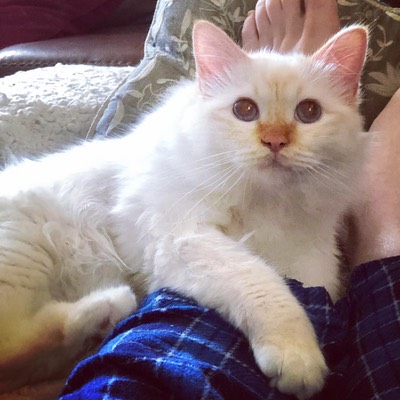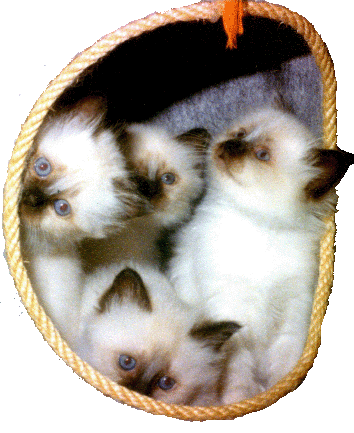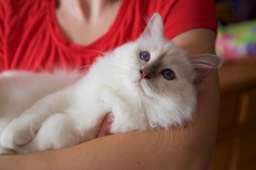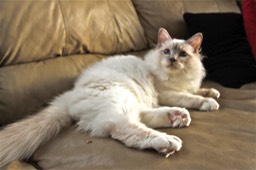Home Page
In Memoriam
- Insolite de la Rose des Vents (seal-Point) was our first important Stud and gave us magnificent babies in the 1990s. He represents the old generation of du Laddak Doré that can be find in many pedigrees.
- Adagio Silkfire was a wonderful chocolate-point Birman who became Supreme Champion with TICA. He was the best Birman for the NE region in 2004-2005.
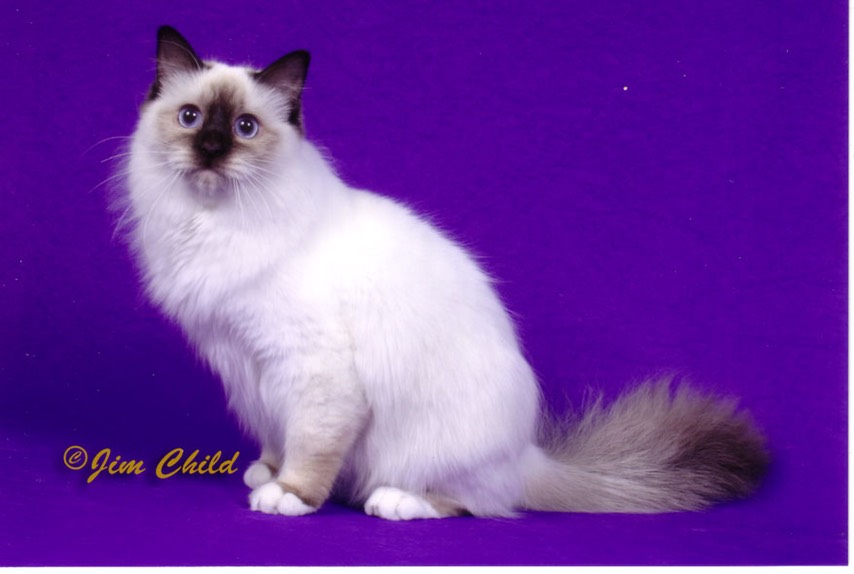

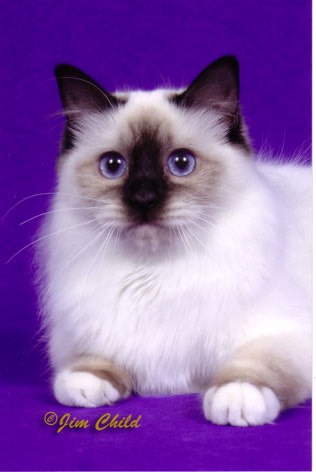
- Prince Caspian was a wonderful loving Scottish fold. We miss him!
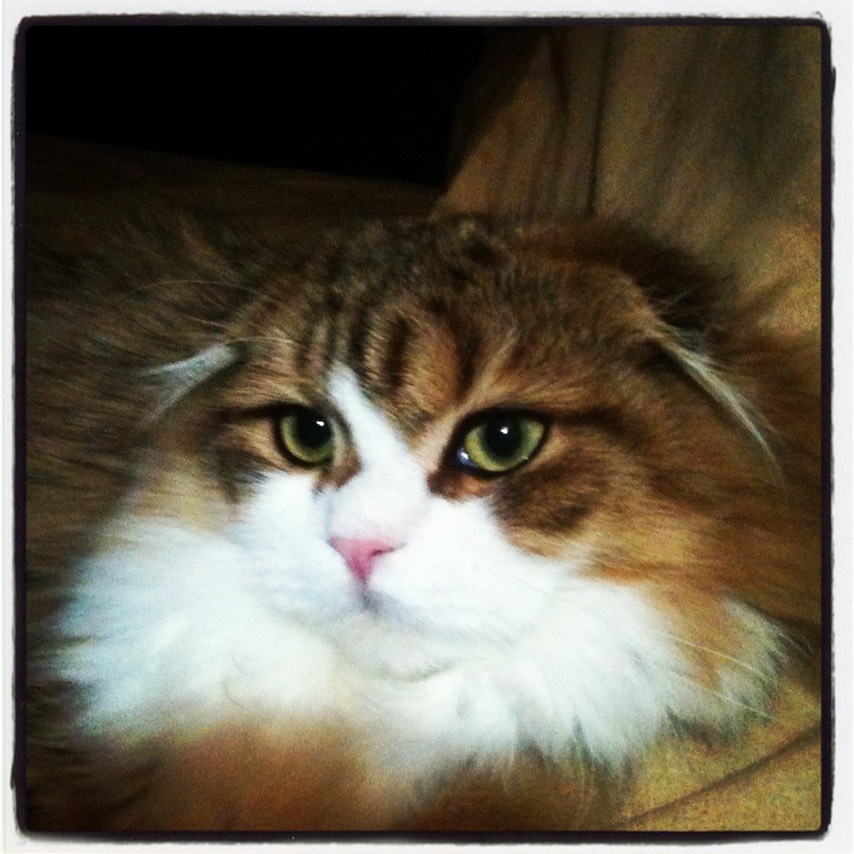
Lubelle du Laddak was a great girl, She ran away in the mountain and, sadly, was never found again. We believe she might have been killed by a car.
Kitten News

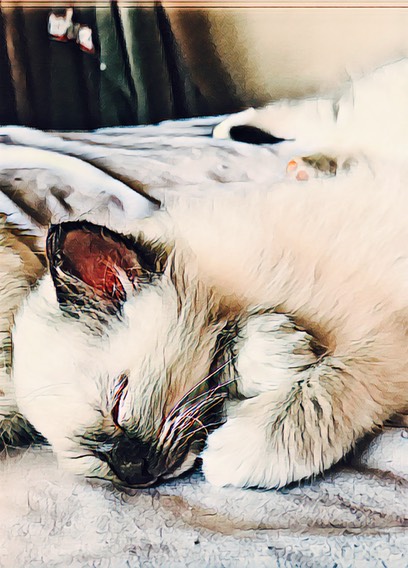
We only produce one litter per year and are not cat merchant!
2022
SPECIAL LITTER with French Boy
We took Olwen to France and bred her with a nice chocolate-point named SWANN du MANOIR d’AMBRE

OLWEN + SWANN
4 Kittens born on July 26, 2022.
(All Babies will be Chocolate-Point)
As I owe one kitten to the male's owner at this time and it costs me a lot to get her there back and forth, the eventual available kittens will be more costly than usual.
All kittens are reservred now.


*****
ALL KITTENS RESERVED
MALE chocolate-Point
TOBLERONE du LADDAK
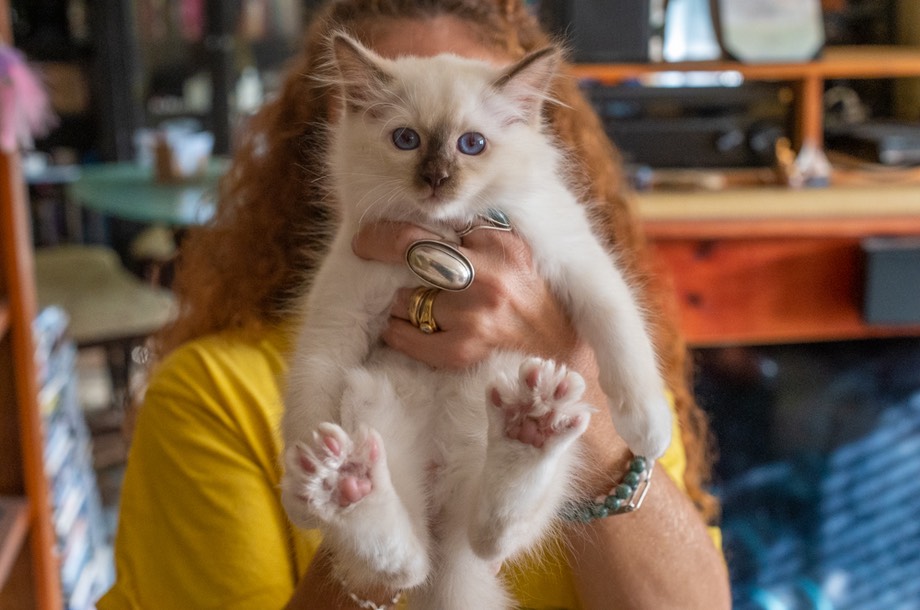
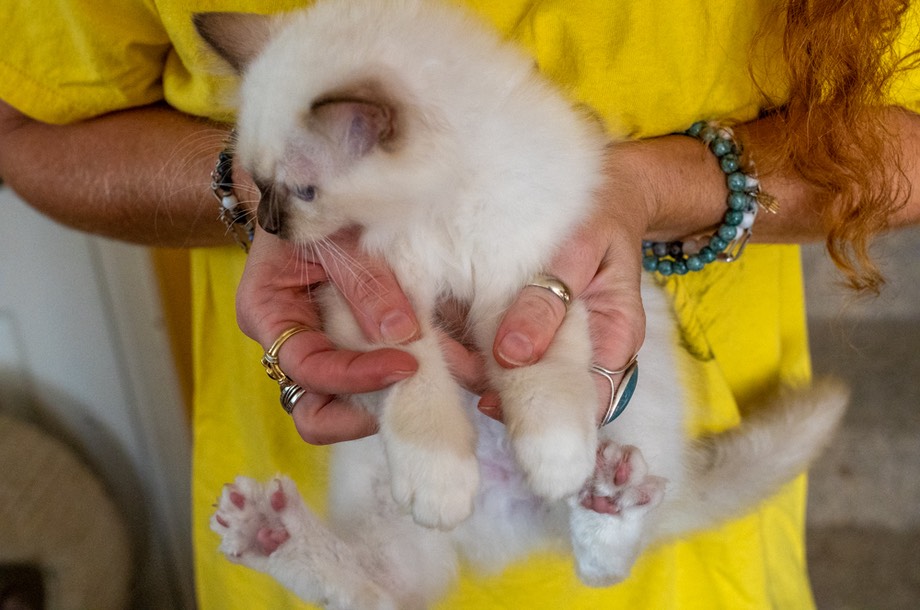
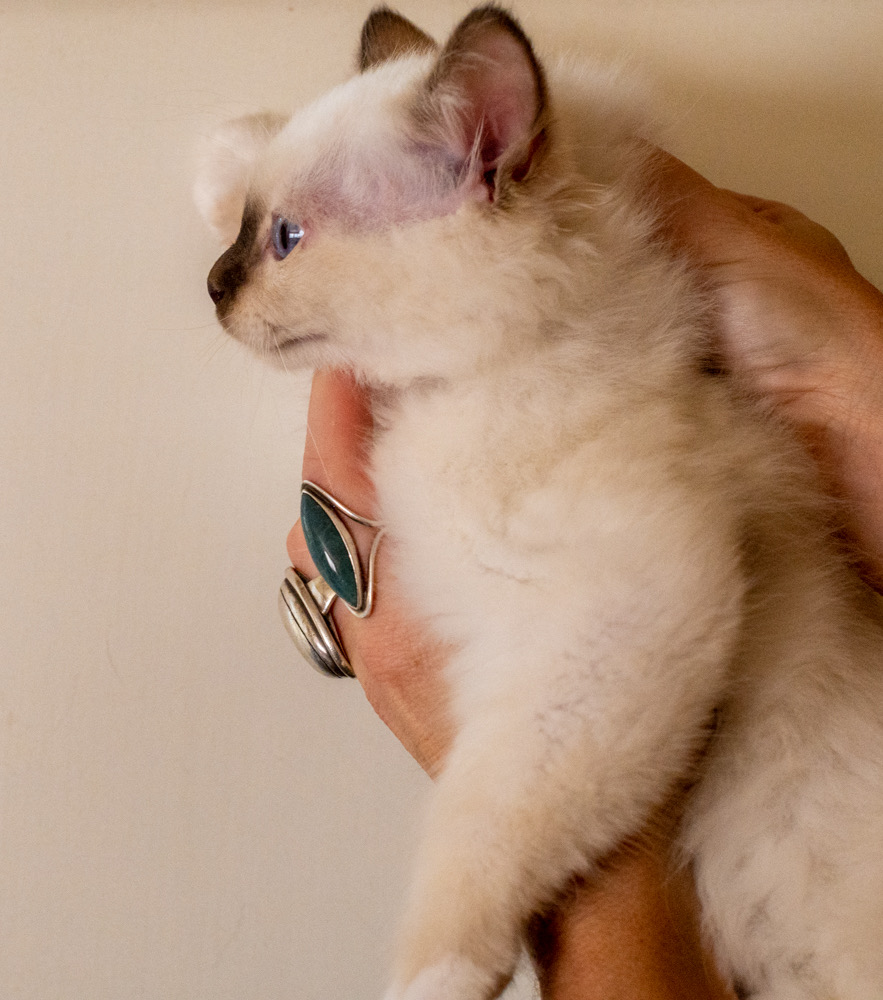
TOPAZE du LADDAK
Female chocolate-point
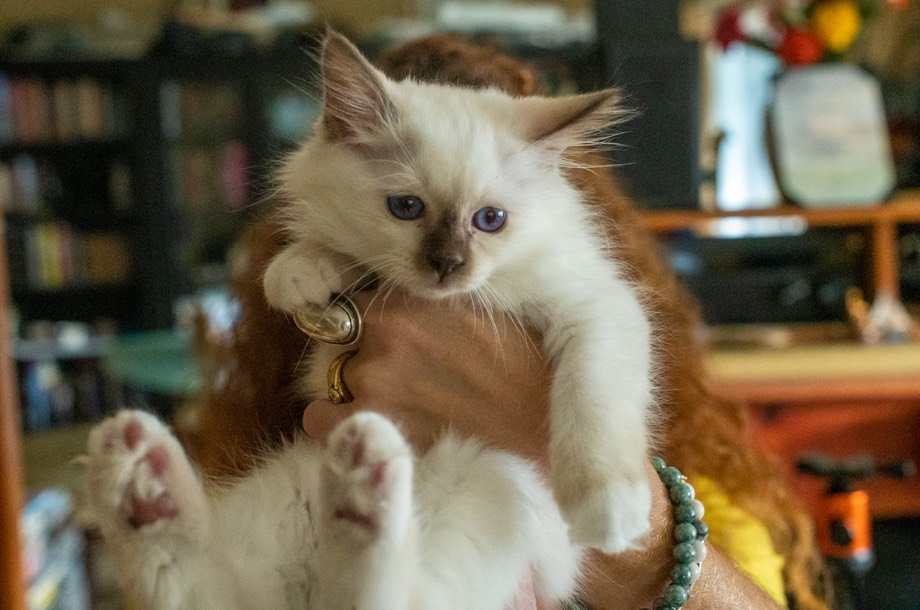


There are 3 males and 1 female in this litter.
_____________________________________
———————————
Send your request below
(Do ot ask iof you are notg on teh listOn
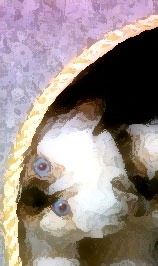
Testimonies
From the previous generations
Pat WALKER - Cyclamen du Laddak -
Hello ...................
Just wanted to give you an update on Cyclamen.
First off, we're calling him "Cody". We went thru a ration of names beginning with "C", and landed on this one. My grandsons helped with the name-picking processing. They liked that one. It seems to fit him.
He's adjusting well. We've bonded, and he is a very lovable baby. Cuddles under the covers with me at night, and purrs me to sleep. He's still getting used to the big house and unfamiliar noises, but is doing just fine. Seems very happy and content. My room is his comfort zone, and he knows where it is.
He and Summer have met twice now ........ she pretty much keeps to her room during the day. They had a few words, and then went to their respective corners. I know it'll take a little time for them to learn about each other. She's mellow enough, and he doesn't seem too aggressive. Hopefully, they'll learn to at least tolerate each other. Tomorrow will be the true test when I have to go back to work, and they'll be on their own while everyone is at work and/or school.
We had our visit with the vet today. He came through that with flying colors. All in all, the doctor said he was in excellent health, and a very good patient.
-----------
Robin EMBREY - Clafoutis (Crash) du Laddak (08-19-2005) - Salinas, CA
Greetings Alain.
Crash is such a wonderful boy!!!! I just love him to pieces!
I have attached a photo of Crash and Gadget.
I am SO very happy to hear from you. Truly, Crash is the best cat I have ever had. He is happy, healthy and very spoiled!!! Crash sends kisses to his Mommy.
Cheers,
Robin and Crash
PS: He is so funny. He still enjoys a banana and also likes avacados.
He is in love with my dog Mars and follows him all over the place demanding attention.
He and Gadget (the blue point) are also very good friends and sound two elephants running down the hallway.
He likes to play fetch too. I throw the ball he brings it back to me!.
I was going to ask you about the fur. He is a fur explosion! Everyone mentions his coat. Of course he is very very soft.
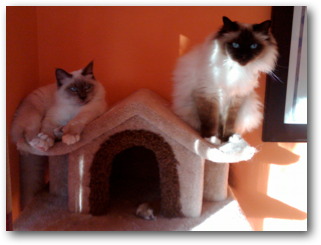
Crash (seal-point)
-----
Melle SALMON Nathalie - Marquise de Charme du Laddak Doré (02-08-1996) - June 29, 1996 - Braine l’Alleud
Marquise est en pleine forme. Elle a vraiment un caractère génial. Elle est très jouette, une vraie puce qui saute dans tous les sens, très caline et prend parfois de ces pauses à mourir de rire mais c’est tellement adorable.
Quand on rentre le soir, elle reconnait nos pas et nous attend derrière la porte de l’appartement. Elle n’arrête pas de me suivre comme un petit chien. Elle est vraiment très belle et a un succès fou, même mon vétérinaire a dit qu’avec des yeux pareils elle allait faire des ravages.
Elles est cajolée, chouchoutée et elle en profite.
Voici déjà quelques photos . Je vous en enverrai d’autres par la suite.
Bien à vous.
Melle Salmon
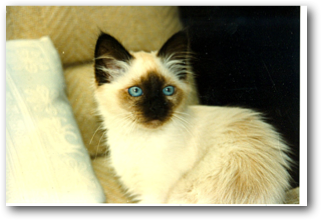
Marquise de Charme du Laddak Doré
--------
Mme MARCHAL Françoise - Belgique
Bonjour Monsieur,
Je n'ai pas le plaisir de vous connaître - mais je pense que j'ai déjà entendu parler de vous, par Madame Béatrice DELVIGNE (qui tenait la chatterie, très réputée, de la Baie des Anges en Belgique) : auriez-vous tenu la chatterie du Laddak Doré, il y a quelques années en Europe...?
Madame Delvigne possédait un étalon magnifique, Mistral du Laddak Doré, qui a ses dires était son plus bel étalon... Je vous bien la croire, j'ai un petit-fils de Mistral (tout à fait le portrait de Mistral, me disait Madame Delvigne) si ce n'est qu'il est seal tabby... mais effectivement très beau... :)))
A l'époque où je cherchais une chatte, j'avais demandé vos coordonnées à Madame Delvigne, mais elle m'avait dit que l'éleveur avait émigré aux Etats-Unis - raison pour laquelle je pense qu'il s'agit bien de vous... :) Si tel est le cas, je n'aurai toutefois pas le plaisir de donner de vos nouvelles à Madame Delvigne: elle est décédée hier..... :(((
En visitant votre site, j'ai remarqué une chatte (magnifique) à l'affixe du Laddak Doré.
J'en viens à l'objet de mon mail: disposez-vous encore des lignées de Mistral...??? Je pourrais être intéressée par un bébé de chez vous, dans un avenir plus ou moins rapproché......:) Les chats présentés sur votre site sont en tout cas magnifiques.. :))
Je suis en tout cas ravie de voir que vous continuez l'élevage du Birman, et en voyant les photos de vos chats, je ne doute pas qu'ils doivent être de grande qualité, tout comme Mistral...:)
Amicalement
Françoise Marchal
Chatterie (débutante ;) de la Drève des Arches
From Pascal MOUREAUX - Iris (Glycine) du Laddak Doré (02-22-1993) - Still alive in 2010.
Cher Monsieur,
Nous avons retrouvé vos coordonnées par Internet.
Nous avions acheté une petite chatte birmane, chez vous, il y a un peu plus de 16 ans... Il s'agissait d'Iris, selon son pédigrée, mais nous l'avions rebaptisée Glycine.
Aujourd'hui, elle est toujours près de nous et se porte comme un charme; en attaché, une photo d'elle.
Bien à vous,
Mr et Mme MOUREAUX
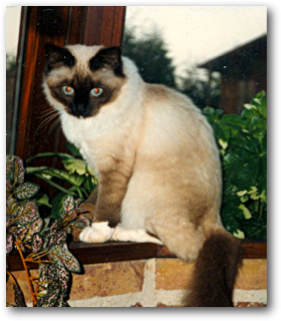
Iris du Laddak Doré
-------
From: Valére VERGEOT - Noisette du Laddak Doré- August 4, 1994 - Bruxelles, Belgique.
En tout premier lieu, un tout grand merci pour m’avoir fait parvenir les documents officiels de Noisette. Les noms de ses parents & grand-parents sont plutôt étonnants!
J’ai retrouvé, en classant mes photos de 1993, d’autres photos de Noisette. Ne sachant plus exactement celles que je vous ai déjà envoyées, je vous les envoie toutes.
Ce petit chat, qui grandit assez vite, est toujours aussi adorable!
Il reste toujours émerveillé devant un bouchon qui se balance, et trouve toujours mille et une idée pour s’amuser et nous faire rire!
Il est terriblement affetueux et recherche toujours notre compagnie.
Bref, les Sacré de Birmanie sont des chats formidables!
Quant à son pelage, c’est étonnant comme il se mofidie au fil des mois. Le plus remarquable se situe à la base des moustaches: il s’éclaircit!
Sa queue commence à s’étoffer, mais il reste toujours aussi beau et élégant.
Vous verrez sans doute mieux tous ces changementrs dans les prochaines photos que je vous ferai parvenir. (Elles ne sont pas encore développées!)
Meilleurs salutations,
Valérie


Java du Laddak Doré Impetuo du Laddak Doré (Noisette)
--------
From Carole MANIL - Irish-Coffee du Laddak Doré - December 8, 1993 - Yvernaumont, France.
Comme promis, les premières photos d’Irish Coffee.
C’est un chaton adorable, il obéit assez bien - Il joue sans cesse, mais sans sortir ses griffes. Il n’y a qu’une seule chose qu’il ne supporte pas: c’est d’être seul, quand il se croit seul, il se met à miauler et à chercher partout soit les chiens soit moi-même. Les chiens l’ont pris comme un petit animal à protéger et tout se passe parfaitement entre eux, c’est même le chat qui le mène par le “bout du nez”!
Il mange bien, il ne rate jamais l’heure. Comme j’ai le temps et que je travaille chez moi, je l’ai remis à 4 repas par jour sur les conseils de mon vétérinaire. Il l’a trouvé très bien et surtout très vigoureux.
Au début il ne ronronnait qu’aux chiens, mais maintenant il ronronne avec qui que ce soit qui le caresse. Il reste assez distant avec les étrangers, mais je préfère. Dés qu’un enfant rentre, il disparait et ne revient qu’après son départ.
Bien amicalement.
Manil

Irish Coffee du Laddak Doré
Legend
If you are gazing around the web, you will find variations of the same legend with some additions and modifications here and there, to the point that people do not know any more which one is the imprimatur one. With time, some breeders have added their own curlicue to the tale, seven bells episodes, like in the Middle-Age, scribes added paragraphs to ancient manuscripts. We are presenting here a translation from the French text- as published in the French review Minerva by Doctor Fernand Méry and quoted later in 1947, in one of the first serious publication about Birmans. This legend was invented by Mme Léotardi the first Birman breeder, and embellished by another lady, also president of the French Cat Federation: Mme Marcelle Adam. The Birman cats DID NOT originated from Burma/Myanmar but were a 1921 creation in France.

The Legend of Sinh
Literal Translation by Dr. Alain L - Du Laddak Birmans,
from Dr. Fernand Méry’s tale published in the Review Minerva and quoted by Marcel Reney in Nos Amis les Chats, Genève: Grasset, 1947, pp. 181-82
“In those days,” began slowly our female friend [this is Mrs Adams], “in a temple built at the flanks of the Mount of Lugh, lived in prayer the venerable Kittah Mun Ha, Grand Lama, precious amidst the precious, from which the very god Song Hio braided the golden barb … There was not a minute, not a gaze, not a thought of his existence that wasn’t dedicated to the adoration, the contemplation, and the pious service of Tsun Kyankzé, the goddess with sapphire eyes, the one who presides over souls’ transmutation, the one who allows the Kittahs to come back to life again in the form of a sacred animal, to the time of its existence, before returning back in a body haloed with the total and holy perfection of the grand priests. Close to the god, Sinh, the dear oracle, meditated. He was a completely white cat, with yellow eyes, from the reflection of his master’s golden barb and from the golden body of the goddess with sky eyes … Sinh, the counselor cat, whose ears, nose, tail and extremities were the color of the soil, the brand of a stain and impurity for all that touches or can touch earth. Now, one night, as the malevolent moon allowed the cursed Phoums coming from the loathed Siam to approach from the holy enclosure, the Grand Priest Mun Ha–without ceasing to implore the cruel destinies–entered slowly in death, with his divine cat at his side and under the anguished eyes of all the devastated kittahs …. Then a miracle happened… the unique miracle of immediate transmutation: at one jump, Sinh was on the golden throne and perched on his saggy master… He braced himself on this head, heavy with years, and which, for the first time was not gazing to his goddess… As the cat stayed in its turn deadpan in front of the eternal statue, one could see the bristling nap of his white backbone suddenly becoming golden yellow. As his golden eyes became blue, immense and profound like the goddess’ eyes. And, as he was slowly turning his head toward the southern entrance, his four paws, which were touching the venerable crane, becoming flashing white until the place recovered by the silk of the sacred clothes. Then, as his eyes turned toward the southern entrance, the kittahs, obedient to this imperative gaze, loaded with hardness and light, hurried up to close the heavy bronze door on the first invader… The temple was saved from profanation and looting… Sinh had not left the throne. On the seventh day, without having made one movement, facing the goddess, his eyes in her eyes, he died, mysterious and hieratic, taking Mun Ha’s soul away to Tsun Kianksé, as he was too perfect for earth now… And when seven days later, the priests assembled in front of the statue, and consulted in order to decide Mun Ha’s succession, they saw all the temple’s cats running up together … All the cats were clothed with gold and white gloves and all their yellow eyes had changed to deep sapphire… Then, all of them in silence surrounded the youngest Kittah, chosen by the reincarnated ancestors according to the goddess will… And now–pinpointed the storyteller woman–when a sacred cat dies in the Lao-Tsun temple, a Kittah’s soul replaces forever his place in the golden god Song Hio’s paradise. But also, she concluded, “Woe to the one who hastens the end of one of these marvelous animals. Even if he didn’t want to. He will suffer the cruelest torments until the sad soul he disturbed finds peace…”
*****
Kittens Price
What is the price of a pure breed Birman with a pedigree? Are these high prices justified?
My answer will give you an idea of how much a breeder is spending to keep up with the cost. Beside the investment for new acquisitions (it differs from one breed to another, from one country to another, a top show cat price can today goes up to 2,000$), other expenses are to be taken in consideration (+ transportation = $700). Price have been climbing a lot this past 5 years in Europe, Australia and New Zeeland (most expensive).
- This is not a very profitable business.
Unless you are breeding at a big scale (and do not know who is who among your kittens and how to keep your kittens clean), an amateur breeder does not really make any money on the kittens he/she sells (unless he/she is a vet). There are a lot of costs associated with breeding. Aside veterinarian bills: vaccinations, visits, health issues (they can get crazy if you have any disease to deal with and it spreads to all your cats), a breeder who goes to cat shows spends a lot of money there too (you have to pay to be in a show and the awards are not monetary, just ribbons and a reputation): entry fees (around $95 per cat at TICA, about $49 in CFA) + transportation + hotel + local restaurants. If you are trying to get titles for your cat, you can multiply that by twice a month, and then, at the end of the year you have spent several thousand dollars. Some breeders have to invest in buildings renovation for their cattery too, and it can be costly there too. Thus, kittens coming from parents with a title (Grand Champion, Supreme Grand Champion) will cost you more.
You are advise to take a Vet insurance when you get a kitten/cat as these expenses can be ridiculous in the USA (10 X more than in Europe. You are basically paying for the Vet pool and big house).
- Some breeders are cat merchants.
Now, I dare to say that, according to my observation for 24 years, there are two kinds of breeders: The cat merchants that see this as a business opportunity to make money; and the cat lovers who do it for the advancement of the breed and want to share their love of the breed with others (rare now). In the past 5 years, I have seen prices of Birmans double.
I recently went to a Birman breeder website who said she had a small cattery and I counted more than 14 cats. This is not a small cattery anymore!
- Importations
However, there are some new factors to take in consideration. One of the reasons for a higher price is that, in order to renew the pool, more and more breeders have to import cats from far away (Australia, Europe ...), and to pay between 1,500 to 2,000$ for a show cat (you have to pay in other currencies and the dollar has lost a lot of value). To add insult to injury, they also have to pay sometimes another close to 1,000$ for plane transportation (pet’s transports are a scam but unfortunately in many places now you are not authorized anymore to get a pet in cargo through a normal airline company without using expensive middle-pet cies services (they can go from $500 to $3,000! - I should write an article on this scam, one of these days, as I keep track of everything).
- Cat’s quality
The quality of a cat is determined by the cat’s standard published by cats’ associations (CFA, TICA, FiFe...). A good breeder will sell you a cat with the paperwork to obtain the pedigree from one of these recognized societies. The price of a cat is based on this standard. There are usually four cat quality degrees (some new breeders only have three qualities. Others sell all their cats as “show” quality. Pay attention! They lie. In the majority of the cases, you do not have all show cats in a litter). It s not becasue you have a Birman cat with nice symetrical gloves that you have a show cat! This is not enough contrary to what a lot of amateur breeders think.
The price of a kitten is determined by the quality of the kitten (not by the fact that you are going to put him/her in a show or not) according to CFA or TICA officials standard.
PET: a kitten/cat from pure breed Birman parents with a fundamental default according to the standard. By default we do not mean a behavioral or health default but a missing trait of the standard. For instance for a Birman, a default could be: asymmetrical gloves or a runner, no laces on the back paws, a white spot on the chin, no roman nose, a weak color, light blue eyes, dark spots on the robe, a knot in the tail, body too small, ... Prices differ from one state to another but, the price of these pet cats today begins around $1,400 (depends on the quality). These cats need to be neutered or spayed and cannot be use for reproduction because of their defaults. At that level, there are usually no difference in price between male or female. When you buy a cat you receive a contract and a cat association paperwork. This paper indicates the quality of the cat and, if it is a pet quality, you have no show or reproduction rights and you will never be able to obtain official papers for any kittens produced from these.
BREED: a kitten/cat from pure breed parents with a minor default according to the standard. May be the cat doesn’t have perfect symmetrical gloves but it has the rest. The cat would not win in a show but can be a good reproducer and produce kittens who might be of show quality. They usually sell around $1,500-$2,500. In the past, I remember that males were less expensive than female. Today, for whatever mysterious reason, it is the contrary, males can be more expensive than females. Go figure out why! I have heard everything in 24 years. It is completely arbitrary. You can sometimes buy one of these as at a pet price without reproduction rights and if you change your mind later pay an extra 500$ to get these rights. It depends of the breeder-buyer’s contract.
LOW SHOW QUALITY: a kitten/cat from pure breed Birman parents with show quality (meaning has all the element requested by the standard -no gloves missing for instance), who may become a champion (with no guaranties - it depends which cats are in competition) but may not be able to go farther up as he/she is not as spectacular as others. Price is above $1,800.
HIGH SHOW QUALITY: a kitten/cat from pure breed Birman parents with top show quality and exceptionally beautiful. She/he could become a Supreme Grand Champion. Price is around $1,500-2,600 (some go as high as $4,000 these days).
RETIRED QUEEN OR STUD: From time to time, some breeders are retiring their queens or studs. These are adult/top show cats and you can buy them for a lower price. To progress in their program, for a lack of room, breeders need to place their retired cats. There is also the case of a cat that do not behave well with others and needs to be the only cat in the house (a jealous cat for instance). This can be your chance to step in and to acquire a show adult at a lower price. The breeder can give you a lot of info on this cat as they know him/her well. They are usually sold neutered or with a neutering contract.
So! Where to buy? Here is my advice:
- Do not buy from a big cattery without having an in depth inspection.
- Be sure the kittens are well taking care of, socialized and clean. If there is a strong smell of cat urine when you visit the place, pass.
- If the price is excessive for the quality, do pass over. Do not get trapped in the cuteness of a kitten.
- If a kitten is sick, do not take him/her until he/she is declared healthy again, by a vet. (By healthy,we mean a main disease. Cats easily catch ticks and flies and benine things).
- If a kitten is shy, aggressive, do not come to you, is not playful, do not take him/her.
- Be sure you understand the contract correctly. The contract should give you some period of health warranties and what happens in case the kitten deceased ; is sold as a show quality and do nothing in shows ; is sold as a breeder and is infertile.
- The breeder should provide recognized Cat Club paperwork to obtain pedigree and official documents from them (you will have to pay a fee to these organizations to get them). The majority of the breeders will send you the kitten/cat's paper only after the cat has been neutered (if you have not bought a cat with reproductions rights).
- Try to get some references about a breeder (specifically about health issues).
- Do not buy in a pet store, but directly form a breeder. You want to know where the kitten is coming from (same issue happen in shelters where a lot of diseases are rampant).
- Have the cat tested by your vet for usual diseases when you get him/her in the next 24 hours you get him/her.
- If you do not have a good feeling with the breeder, pass!
- There is a Birman adult rescue center that is followed by Birman associations. You might have a chance there if you have a limited budget.
Sitemap
Home Page
- Kitten News
- Our ACTIVE Cats (2022)
- Du Laddak Cats in their family
- Kittens Price
- In Memoriam
- OUR Watercolor art
- Legend
- KITTEN REQUEST QuestionnaireBeta
- About me
- Cats Magazines
- RETIRED CATS
- CH. ORLANDO du LADDAK (USA)
- Valinka Laty Mery (CZ)
- CH. LUBELLE du Laddak (USA)
- Cookie Namrib (ENG)
- Galiléo de l’île KohTAo (FR)
- NOHLAN du Menne-VAl (FR)
- CH. Wilson de la Baie des Amours (BE)
- CH. Java du bleu Nathier (Be)
- OBIWAN du Laddak (USA)
- CH. NORMAN de Chatterley (FR)
- Noela du Laddak (US)
- PINOCCHIO du Laddak
- Blog
- Links
- Description of the breed
- Cat transportation
- Children Corner
- Testimonies
- Temperament & Personality
- Basic Colors
- Sitemap
- Photo Weblog
Basic Colors
History of Color Creation

Color Creation dates
1924-1958: Seal-Point only
1959: Blue-Point
1977: Chocolate-Point & Lilac-Point
Codes: SBI: Sacré de Birmanie = Birman
1. SEAL-POINT - Code SBI n:
The First Birman (in the 1920s) came from siamese lines that were seal-point [black cats with the siamese gene that only colors the cold body extremities and leaves the rest (the warmer parts) white] and direct descendant of the first Siamese imported from Thailand at the end of the nineteenth century and at the dawn of the twentieth century. It is well recorded, in Siamese catteries, that random siamese kittens were born with long hair (what we call today Balinese or Javanese) from short hair parents. They were usually eliminated as undesirable (cf. History of the Balinese cats if you wish to know more). Important breeders of the first times were Mrs Arlette Poirier (de Crespières) and Mrs Gamichon (des Grandes Chapelles) who founded in 1961 the Cercle Sacré du Chat Sacré de Birmanie et du Persan Colourpoint.
2. BLUE-POINT - Code SBI a:
In 1955, the first Birman carrier of the blue gene was Éloi-Eryx de Madalpour (Mrs Chaumont-Doisy). At the end of the 1950s, the French cattery des Muses used a Blue Persan (Bluette de la Côte d’Azur) to create the new Blue-Point color (a dilution factor of the seal-point). The result was Iris du Clos Fleuri (1959-08-21) in France. In United Sates (Tacoma, Washington), one of the first and most famous blue-point (found in many pedigrees) was Griswold’s Burman Boi Bleu (1964-10-12) [Owned by Mrs Gertrude Griswold. She later changed her cattery name into Clover Creek]. One of his famous blue-point grand-daughter was Ghandi von Assindia, a German cat imported in England by Mrs Fisher (Praha Cattery).
- CHOCOLATE-POINT - Code SBI b - LILAC-POINT - Code SBI c:
In the 1970s the United Kingdom became the main production center of the new colors. Quarantine laws (6 months) forced breeders to work in closed circuit. The first new creation was the Chocolate-Point and its dilution companion, the Lilac-Point.
Circa 1975*, two catteries began to work hand in hand in a scholarly way, to produce a Birman with the chocolate-point/lilac-point pattern. In order to do so, they used two breeds beside the existing Birman: the Colorpoint (Himalayan) Persian for the lilac side and the Siamese for the chocolate side. This choice had the advantage to preserve the blue eyes , the long hair genes, and (via the siamese) the silky coat version. These two catteries are:
-Shwechinthe Cattery (Dr. Elizabeth Brigliadori in Charlbury, Oxfordshire, UK). We should also add here the indispensable previous work of Mingchiu Cattery (Mrs. J. P. Harding one of the two founders of Colorpoint Persians (Himalayans)).
-Mandessa Cattery (Mrs Shirley Wilson-Smith).
*(The color was only recognized by the GCCF in 1993.)
How did they do it?
(Give to Cesar what belongs to Cesar!)
- 1975: Recessive Genes. The Shwechinthe cattery used a colorpoint lilac persan: Mingchiu Manakini (1971-08-19) (from a colorpoint chocolate persan sire and a lilac persan dam) and a blue-point Birman (Ambur Blue Thongwa)*, to create a male: Shwechinthe Mandessa (1975-08-10), an in-between blue cat (lilac carrier).
* From the German Ghandi von Assindia Line.
MALE
Colorpoint Persan Lilac + Blue-Point Birman = Blue Cat (+gene c)
Mingchiu Manakini + Ambur Blue Thongwa = Shwechinthe Mandessa

Mingchui Manakini (Persan Colorpoint lilac-point)
- 1976: Dominant Genes. The Mandessa cattery used a chocolate siamese: Dear Dominic (1970-03-22) and a seal-point Birman (Cragland Darlene) to create the in-between black female cat Mandessa Abygail (1976-05-11) (chocolate carrier).
FEMALE
Siamese Chocolate sire + Seal-Point Birman dam = Seal Cat (gene b)
Dear Dominic + Cragland Darlene = Mandessa Abygail -FEMALE
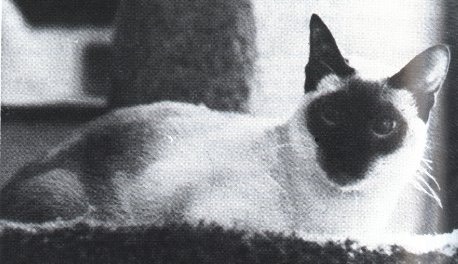
Dear Dominic (Siamese - chocolate Point)
Note: This work and combination respected harmoniously the origin of the Birman; the work of previous French breeders generations, and kept the type of the Birman similar (coming on one side from Persan Himalayan cats and on the other from Siamese cats). It was also smart to use a seal and a blue line on the Birman side to be sure they would produce those in their lines. This also had the advantage to add two new genetic pools together: the lilac and the chocolate lines. 50% of these cats were made of a new genetic pool for the Birman breed, thus renewing the blood.
- 1977: The two were wed together in Spring 1977 to create the first cats with 4 possible colors in July:
Blue Cat (gene a + c) + Seal Cat (gene n + b) = Chocolate-Point Birman (gene b + c)
Shwechinthe Mandessa + Mandessa Abygail = Mandessa Bianca & Mandessa Brita (FEMALE)
c.1. The first important chocolate female created on the Mandessa side was Mandessa Bianca (1977-05-30) and then Mandessa Brita (1977-07-20)
c.2 To diversify the line, Shwechinthe used also another combination. A chocolate colorpoint persan cat named Mingchiu Nobbi (1975-07-10) was wed with another Seal-Point Birman (Cragland Ionne). It created a new in-between chocolate-point male, cat, Shwechinthe Aero (1977-05-30).
Blue Colorpoint Persan + Seal-Point Birman = Chocolate-Point Cat
Mingchiu Nobbi + Cragland Ionne = Shwechinthe Aero (MALE).
c.3 the two lines were wed together to create the new Birman chocolate generations
MANDESSA BIANCA & MANDESSA BRITA + SHWECHINTHE AERO
From this combination came the 4th generation:
a. On the Mandessa side with Bianca: Mandessa Coral (1979-05-31)
- On the Shwechinthe side with Brita: Shwechinthe Maidenless Coco, Cabora, Topaz and Candice (Lilac) (we only mention cats who had an offspring). These cats can be find in today pedigrees of chocolate and lilac Birmans.
Note: This research work is based on a study of the Birman pedigrees archives.
Pictures of the first Chocolate and Lilac Birmans
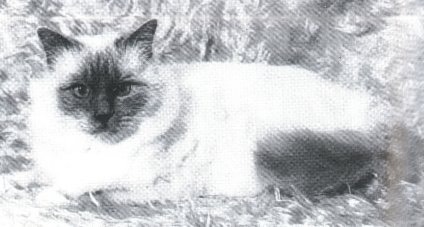
Shwechinthe Akyab (Lilac)

Shwechinthe Kybo (chocolate)

Swechinthe Mayo (Choco) & Aliny (lilac)
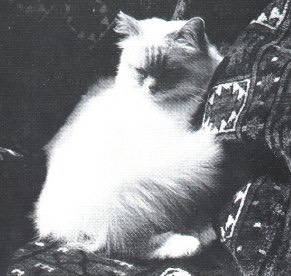
Swechinthe Tuzu (lilac)
Description of the breed

A Birman is a cat with sapphire eyes, clothed with silk and wearing a velvet mask, with the most immaculate white gloved paws.
The position of the gloves, its type and color made the Birman one of the most complicated and difficult cats to breed (compared to a Ragdoll for instance).
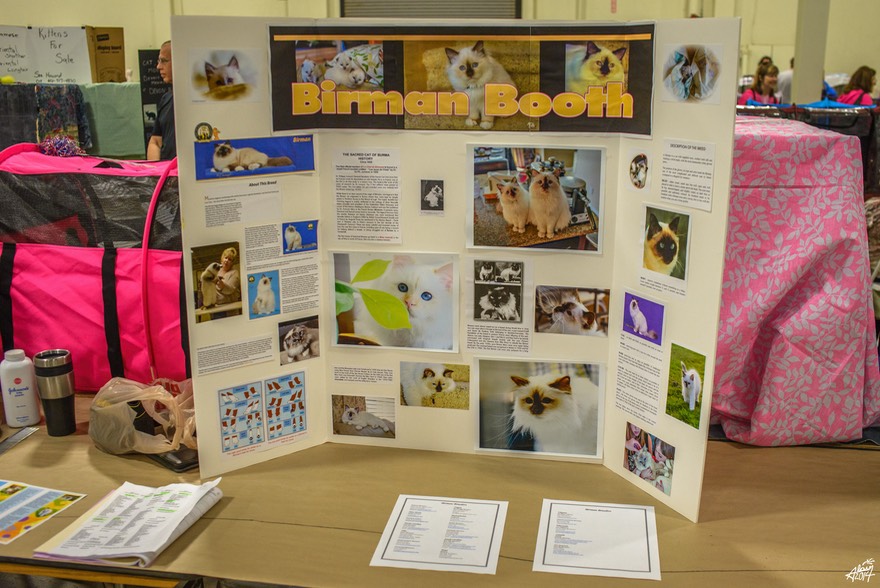
HEAD : rather round, small ears but well open and well placed in order to leave a dome above the head. The eyes must be big, almond-shaped, and slightly round, as dark blue as possible and uniformly colored. Its forehead needs to be bombed, with a Roman nose and a strong chin in line with the nostrils when you see it from profile.
BODY : massive corpulence without resembling to a Main-Coon (males weight between 11 and 13 pounds, and females around 9 pounds), low on paws.

TAIL : as thick and fluffy as possible and with no nods or kinks.
ROBE : semi-long hair with a nice fur collar around the neck in winter time.

HAIR: semi-long and as silky as possible. A traditional Birman doesn’t have hair that tangles like a Persian (one of the issue with today crossing with Persian lines to create the new colors).
COLOR : The robe must be as clear (white) as possible in order to contrast well with the points which needs to be of a uniform color on the triangle of the head, the pawns and the tail. Colors are either: seal or bleu ; chocolate or lilac ; red or cream, tortie (seal, chocolate, lilac cream, blue cream) silver or smoke ; all these colors exist in tabby/lynx (tiger face) or unified points.
PAWS : The white gloves must end at the plow of the front paws ; the white rear gloves must be identical to the front gloves on the top of the pawns and in symmetrical (triangular laces/spur in 7/8rd of the paw) on the bottom.
The two tables show the limits. First table is the lowest markings. The second table, the highest marking authorized.
Redhibitory Defaults
A knot in the tail, strabismus, a drop of milk (chin), points in the laces, white drops in other places than the gloves or laces, absence of laces/spur, fingers recovered by point color, head too Persian or too Siamese, nose insufficiently Roman, eyes too pales, lack of morphology…
As it is so hard to get the perfect Birman, distinctions are made between the following (and price is equivalent):
- •A pet quality cat, with a few defaults according to the standard, and it is unadvised to reproduce.
- •A breeding cat, with also some defaults but also some qualities interesting for reproduction.
- •A Show cat, who meets all the necessary basic criteria and who can become a champion without problems.
- •A Podium cat, perfect, ... rare and exceptional !
About me

Since I was a small boy, I had always dreamt about having a cat. I think the Walt Disney movie, The Aristocats, might have had a strong impact on me too. We were living in a small apartment in the city and my parents didn't have any pets except small parrots that only my father could touch. The only animal close to a pet I "officially" owned was Pinocchio the red fish. I also had "secret" white mice that I kept outside, in a box, at school...
My parents used to put me in summer camps for three weeks, every summer. I do not know why, but I was always the one picked by cats in camps. They sneaked in, slept, ... and pee... on my bed! There was a special relationships between us!
I tried on several occasions to introduce a kitten in the house. It began with wild feral cats caught in the neighborhood’s backyard, but my father always sent them back, upset, menacing to kill them in the toilet, and I was left spreading all the water of my eyes!
Then, the promised day came after my bachelor degree. I was by myself in an apartment and free of choice. Well, almost free of choice because my first rental contract stipulated that "not pet were allowed". I had mice in this apartment, provocative mice, and my landlord was living in Switzerland 10 months per year. I did try to get rid of the little rodents by several meanings but without any success, they were spreading like ... mice ... and, after a while, did not bother to escape when I returned home. So ... I had to do something ... and this provided a good excuse to introduce .... a Cat in the House!
Thus, my decision was made. But, what kind of cats would I have? I decided to buy a book about cats. It was the “Larousse du Chat”, an encyclopedia that listed all the breeds. In one day, I had read the entire book and my eyes were amazed by the beautiful picture of one striking feline ... A Seal-Point Birman. I was mesmerized when I saw it! My search was completed.
I took the yellow pages, called the Cat Club of Belgium, and asked for information. A Cat Show was going to take place that week-end in Bastogne, so I went. I had never been to a Cat Show and was quite excited. There were, indeed, two magnificent Birman kittens for sale, from Germany, but the price was prohibitive, over my small budget and I couldn't afford one.
I came back home sad and read the book again. I had to pick up a cheaper breed! Another breed that had got my attention was the Persian Colorpoint, so I called the Cat Club again and was referred to a Persian breeder in my city (cattery of Gofforth). I went to visit her. She had a female seal-point for sale and asked me if I also want to take her brother, for the same price. He had heart problems (a deformation) and she was not sure how long he might live (he died in fact from a heart attack, months later). I took the two and came back home with my new cats. As I became friend with this breeder, I found myself quickly involved in Cat Shows...
My mother had begun the last phase of her leukemia, but was not aware of it, and the doctor gave me hope first. I decided to get her a companion cat as we were not living on the same side of Brussels. My heart was still set on Birman. I was able to acquire a pet quality blue-point female named W’Aril a san (from Dutch origins: Snozepoesjes) that I soon re-baptized Wickie, from the Kleetbos cattery, Mme Nadine Mellaerts, for a reasonable price. I didn't really chose Wickie. She picked me. I knew -at that time- close to nothing about Birman standard extreme specifics. She had irregular gloves, one runner, and was not show quality at all, but she had an outspoken personality. Amidst all the kittens for sale, she came straight to me and fell down inside my hand, as saying : "You are the one, take me with you, pleassssse!" That's how I chose her, with my heart. I gave the cat to my mother. Unfortunately, my dear mother passed away on August 23, 1986 and I took Wickie back with me. One week later, to change my mind, I put her in a cat show in Waterloo, on August 31, 1986 and the judge (Mr. Rossi) asked who had put this kitten in the show, because she was really not a show quality! I was embarrassed but was such a rookie at that time. She made Excellent 2nd female as there was only three kittens in her 3-6 months class! I still have the judgment which reads: “Front gloves too high with a runner. Nice back gloves but high. Nice head with contrast and good eyes. Ears well placed and contrasted. Excellent coat. Well presented, uniform. Excellent tail well contrasted. Excellent condition except for the gloves!”
Wickie (our 1st Birman)
Wickie was the beginning of my cattery, my first generation of Birman. In becoming a member of the Cat Club de Belgique, led by Mme Rossi at that period, I find myself involved with secretary work with Mme Rossi. I also met Birman breeders.
- 1st Du Laddak Doré Generation:
I had no male and became friend with the Antoine (Andara & Chidwin cattery), the main Birman breeders in Belgium at that time. They had a blue-point male stud named Ricky Jachara (from Holland’s lines: Snowepoesjes) that was, as a matter of fact, the grand-father of my cat (as I discovered later), and I mated Wickie with him, on January 20, 1987. Wickie gave birth to my first four kittens, on March 22, 1987, a Sunday, 61 days later. They were, of course, all blue-point, one male and three females: Arakhan, Amanda, Ava and Amara-Pura. None were show quality, of course. As I needed a cattery affix name to record them, my Persian Colorpoint friend, Mme Verzin, told me I could use her name and they were de Gofforth.
At the same time, meanwhile, I presented a blue-cream colorpoint Persian in the Brussels’ annual big January Cat Club de Belgique show that made the Best in Show Kitten 6-10 months. I had acquired her from my colorpoint breeder friend’s cattery.
I was very lucky to have my four Birman kittens on the television Animal weekly Show, because my vet (Dr. Yvan Beck) was a very famous university vet in charge of the pet TV programs on RTL. So, with my little knowledge of Birmans, I had 5 minutes on National TV.
Mme Antoine was also doing Persian Chinchilla at that time. She had a female silver, named Tania that she was trying to place somewhere, as it didn’t fit her program. She asked me if I want to take her. She had been rescued from a traumatizing place and was hiding most of the time. I felt compassion for this cat and took her with me. I was interested by Golden Shade Persian, a quite rare color at that time. When Tania was in heat, I went to Holland and mate her with a Golden-Shaded Persian named Esteban (Mme Alstede). From this mating, I got two kittens in August 15, 1987: one silver male Persian, Argentin and one Golden Shaded Persian female, Ophyre that I sold to a Persian chinchilla breeder in Belgium.
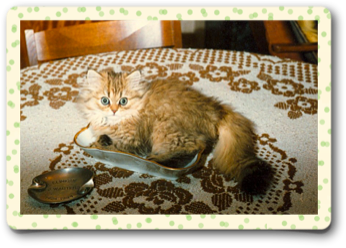
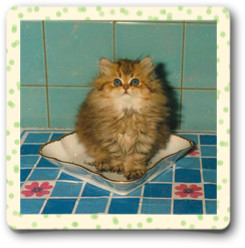
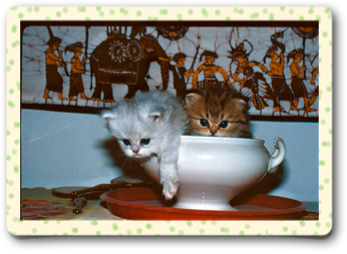
From the four Birman kittens, I kept one female: Amara-Pura de Gofforth.
In November 1987, I left Belgium to work with poor people in Haiti. I placed my three cats in some friends’ house, waiting for my return.
Three years later, in 1990, I came back to Europe and moved to Roquebrune Cap-Martin, in France, and worked one year at Beausoleil, above Monaco (where I was born). This was the originated area where the first Birman had been created in the 1920s. From my previous work, I was only able to recover one cat: Amara-Pura du Laddak Doré.
I registered an official name for my cattery in 1990 at the French, Federation Feline Française, after a visit to Laddak, in India, and called it : Du Laddak Doré. Cattery # 7.93.4843. The addition of Doré to my affix was a reference to Buddhist temples I had seen in Laddak, and well represented also in Burma, the country of the Birman cat legend.
Amara was the mother of the first Birman kittens with this affix name. This became official on July 19, 1991. Amara was mated with a Blue-Point male named Felipe du Chêne Heureux (La Perle d’or and La Renouée behind) and she gave birth to three kittens, one male and two females, all blue-point: Globule, Glycine and Guimauve. I kept Glycine du Laddak Doré.
In 1992, I moved back to Belgium, in Rixensart. Glycine was mated with one of the first Seal-Tabby Birman in Belgium, imported from England: Julipaul Tigerface. She gave me three kittens, on February 22, 1993, 3 females. One seal-point, Iris du Laddak Doré, one blue-point, Isis du Laddak Doré, and one blue-tabby-point, Idylle de Printemps du Laddak Doré (my favorite girl and first tabby-point). She had nice blue eyes, nice big gloves, but the right one was too high. I kept her. The Blue-Point girl, Isis, went to Limelette, to Mme Ska Clara, and the seal-point male, Iris, to Mr. Moureaux in St Jeangeest.
Iris du Laddak Doré (02-22-1993) - 16 y.o. here.
Isis du Laddak Doré (Capucine) (02-22-1993)
In February 1993, Amara was mated with a seal-point from another Birman cattery I knew: Alandor de Grand Lahou. She gave birth to two kittens. I kept a female seal-point named Isabeau du Laddak Doré. She had the look of the Perle d’Or. Glycine was in heat again later that year and was mated to Alandor de Grand Lahou. She gave birth to three seal-point kittens, two males and one female: Irish-Coffee, Impetuo and Indian-Lady. Irish-Coffe went to live in France in a small village (Yvernaumont) with a mayor lady, Mme Manil and her two dogs. Impetuo du Laddak Doré went to live with a nice lady in Brussels, Mme Valérie Vergeot.
- 1994 was the worst year for du Laddak Doré. I went to breed Glycine to the same place with Alandor and discovered the lady (a vet!) had just acquired another nice blue-point male left over somewhere. In studying the pedigree, I discovered this cat was a descendant from one of the cat I had admired the most in Belgium (Basilic Bleu-Nuit de Maoucha - imported by the Antoine not in business anymore) in shows, years before. She had just acquired this beautiful cat a week before and I asked to breed him with Glycine. Little, did I know that this cat had a virus, trusting a vet, and Glycine died quickly and infect the rest of my cats (this male cat died too). I lost most of my cats but was able to save Idylle de Printemps but not her ability to breed again. Amara, fortunately, was living with a friend at that time.
This event was an awakening to me. While the lady vet refused to recognize any responsibility, I was disgusted and I decided to work differently. This was the beginning of my search for a male of my own to work in a safer environment.
I did several mating with Amara and Apollon du Val de Gwen in La Louvière area (Mme Neeman Regine), a nice seal-point stud. Three kittens were born in 1994: Jaïpur, Jena and Java du Laddak Doré. Mme Valérie Vergeot from Bruxelles, bought her second cat from me: Java du Laddak Doré (and nicknamed her Galopette) to add a companion to Impetuo (her half-brother). Amara-Pura was spayed (she was already living with friends), thus ending this first generation.
Impetuo du Laddak Doré

Java du Laddak Doré
- 2nd du Laddak Doré Generation (new line):
I decided to buy a new female from Mme Neeman, and picked up a nice seal-point girl named Jade du Val de Gwen (03-19-1994). She is the second new generation of du Laddak Doré (Julipaul Tigerface line).
She was mated with Apollon du Val de Gwen in April 1995 and gave birth to three kittens, one female and two males, all seal-point: Lexie, Lautrec and Lafayette du Laddak Doré. Lexie was bought by Mme Malache Anne who came later for stud service with Insolite.
Lexie du Laddak Doré (1995)
I also decided, at that time, to buy a blue-point male from France, Lyon area. It was Junior du Manoir de St Goustan (07-22-1994). I went to Paris to pick up the cat at the Lyon Railway Station and came back with him by car. I isolated him from my cats and noticed he had some eczema and tinea. I went to visit my vet directly to give him a treatment but he was not looking very well. The poor boy died from FIV in not even 3 weeks! His mother had disappeared in nature, In Lyon and never came back. I had the most annoying bad luck and more sadness to add to my previous adventures. I was back to zero on my male quest. I almost got a nice seal-point male from Germany (Hamlet de Bassecour) but it did’t happen.
Junior du Manoir de St Goustan
Finally, perseverance was fruitful. In 1996, I was able to locate a seal-point male 3 y.o. for sale in the Brussels area, sold by a breeder who was stopping breeding at that time, and who happened to be ... the breeder of my first Birman cat (Kleetbos)! The spectacular, all in fur male she was selling was in fact a Parisian cat, Insolite de la Rose des Vents (03-28-1993). This was the nice combination I was hoping for.
Insolite de la Rose des Vents (Breeder: Mme Claudel)
Insolite was mated with Jade for the new generation. In 1996, he gave birth to four seal-point female kittens on 08-02-1996: Mandalay, Mélodie Enchantée, Marilyn and Marquise de Charme du Laddak Doré. These were my first quality show kittens produced. I kept Mandalay and Myosotis du Laddak Doré who was magnificent and won all the shows. Mandalay did also well in the Mouscron Cat Show in 06-02-1996 where she was Excellent 1st kitten 3-6 months, Best of Variety and Best in Show. Myosotis also made the Best in Show in 1997, beating all the other Birman present. Mélodie went to Wavre, to Mme Paule Soetewey; Mandarine to Bruxelles, to Mme Riss Heddy.
Jade was put again with Insolite and gave birth to 6 fat kittens, 3 females and 3 males, all seal-point: Mandarine, Myosotis, Mimiou, Mistral, Mandrin and Mirabeau du Laddak Doré (06-25-1996). It was a magnificent litter. The prettiest one was Myosotis and then Mandrin. Ironically Mistral du Laddak Doré was the lowest quality in this group (he is the one that is found in many pedigrees today via the cattery of la Baie des Anges and du Mas d’Orphée. He is the grand-father of Timo du Mas d’Orphée). He had, according to my notes, a left runner, short front gloves, however a very pretty head and a magnificent coat and nice strong morphology.
Myosotis has also repoduced and is found in North of France’s lines.
Myosotis du Laddak Doré
Made in USA
In 1998, I moved to the United States (Boston area, MA, and Storrs Connecticut) where I completed my education and began long studies leading to my PhD in French Literature.
In 2000, I was able to have Mandalay shipped to me to Boston from Brussels. I tried without success to have Myosotis back (my best female), but she was stolen from me with many lies (she had one more litter under my cattery name without my authorization (04-29-1998)- as I discovered by coincidence through pedigrees studying) and I never got her back or heard any news from her. This is one of my main regret as she was magnificent for these days standard.
Mandalay du Laddak Doré
I recorded my cattery name at CFA & TICA, but had to drop de DORE part because US Cat clubs only accept one word name. This is why the name now is Du Laddak (or Laddak) only.
Having no male I looked for an available stud in CT and found the Elpis cattery (Corinne - Elpis Cattery) and began to work with her and her blue-tabby-point male: Champion Taron Xerxes of Elpis. He gave me Zimra du Laddak Doré, seal-tabby-point female who was the mother of Belladone du Laddak. Zimra du Laddak Doré was my first half-European / half-American girl. She gained her Championship in TICA Shows.
Zimra with her kittens
Arthur du Laddak (08-11-2003 - 2013)
NEW QUEST FOR A MALE
I began to look for a male at that time and bought Jedi (blue-point) in 2002, from the Taron’s cattery in North Carolina, during the annual Birman Cat Show on the East Coast. Unfortunately we discovered that he had some strabismus as underlined by a judge. We had to neuter him and could not use him. He is still living with my friend Dr. Anne Berthelot in CT.
At the next Birman 2003 annual show in New Jersey, we bought Silkfire Adagio. He was a magnificent Chocolate-point cat from American and Australian lines (Belshogar cattery). Adagio won all the prices in Cat Show and became my First Supreme Grand Champion in TICA. He was the Best regional Birman cat in New England for that season. Unfortunately he had come to me with FIP and died in January 2005, at not even 2 years of age. I was devastated.
Silkfire Adagio of du Laddak
The TICA show where Adagio became:
Supreme Grand Champion Silkfire Adagio of du Laddak
(06-05-2003 - † 01-2005)
Chief Cowan du Laddak (08-19-2005)
Diego du Laddak/Samuraï (Blue-Tabby-Point) (05-2006) beside his mother’s picture. He is the last du Laddak from the 2nd generation.
- 3rd New Generation du Laddak (new line)
2010 - today After a four years halt, we finally got the right lodging conditions to resume again. Learning from our past experiences; knowing what we are looking for, and aware of the downside of breeding and the dangers paved on the road, we want to stay small, healthy, to produce strong loving cats and therefore, have become very picky in what we are looking for. You can check the other pages to discover the new generation in San Diego, CA.
In 2019, we have two females and three males actives.
In Memoriam.
Marin † 2010 (a little loving baby bird I tried to save.
He was killed by another bird while learning to fly… ;-(
Photo Weblog
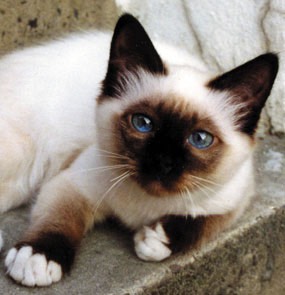
Myosotis du Laddak Doré
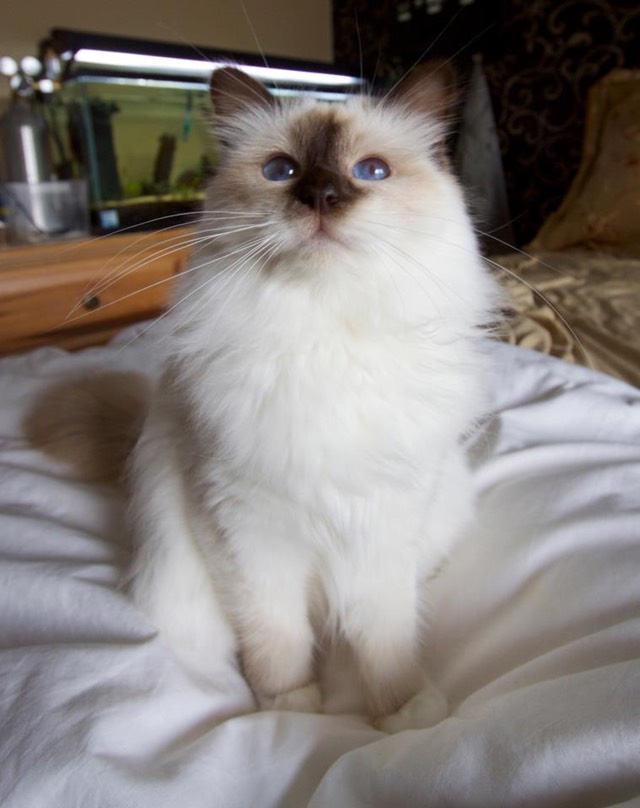
Namrib Cuckoo in the nest (Cookie) (Chocolate-Point)
Galiléo (Lilac-Point)
Our ACTIVE Cats (2022)
GIRLS: Olwen du Laddak & Samantha du Laddak .
OLWEN DU LADDAK (USA) CHOCOLATE-POINT
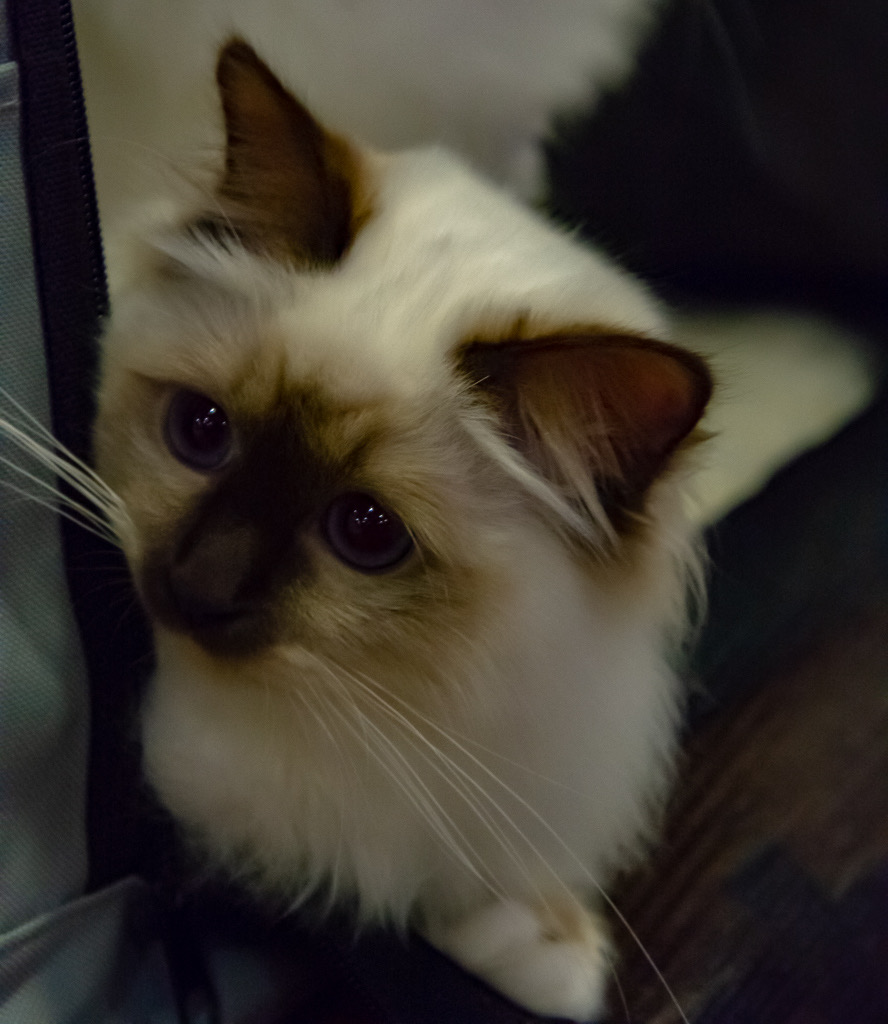
SAMANTHA DU LADDAK (USA) CHOCOLATE-TORTIE-POINT
***
Boy: Télémaque du Manoir d’Ambre Chatterley.
*****
